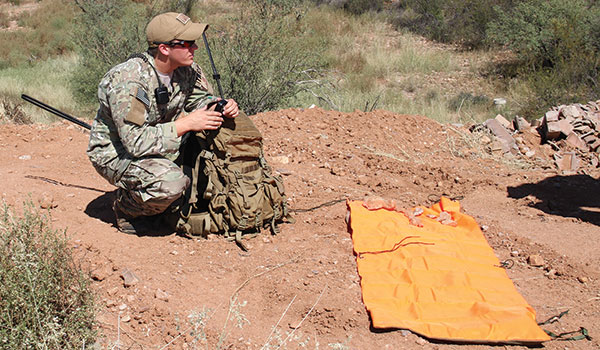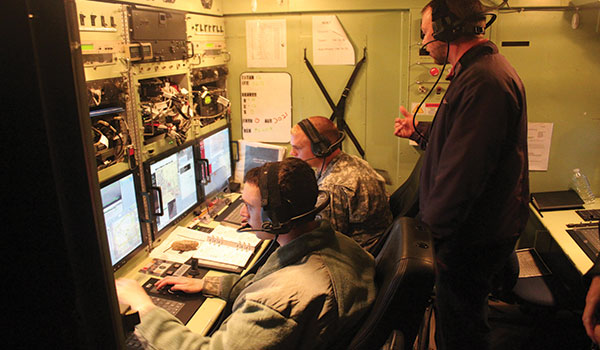
Unmanned Aircraft Systems / By LTC Daniel L. Isabell and CPT Justin M. Kuhlmann: Experience is often what separates the victor from the vanquished. As such, coordinating and resourcing realistic training that best replicates the adversities of combat will always be one of the cardinal objectives of any commander. The current situations in Ukraine, Syria, Iraq and elsewhere show us that the modern battlefield remains as dynamic and fast paced as always. Inexperienced or poorly trained armies have a tendency to approach combat reactively, practically ceding the position of relative advantage to their opponents. On the other hand, challenging, realistic training provides Soldiers with an analog of combat experience that can, over time, enable Soldiers to anticipate events rather than react to them.

An F-18 and MQ1C during a night assault above Hubbard Intermediate Staging Base (ISB) (simulated)./ ALL PHOTOS 2-13TH AVN. REGT. COURTESY PHOTOS
Currently, the average time between Soldiers graduating from unmanned aerial vehicle (UAV) training at Fort Huachuca, Arizona to being deployed in support of an overseas mission is less than 12 months. This is a significant limitation on the amount of time that a 10 level Soldier can gain relevant experience from realistic training. In order to mitigate this, the 2-13th Aviation Regiment, 1st Aviation Brigade, is working on ways to incorporate training that reflects the current combat environment into the 17 UAV programs of instruction (POIs). By operationalizing critical training tasks, Soldiers will have a better understanding of the purpose of the skills they are learning, and be better prepared to integrate into the realistic training plans of their future FORSCOM units.
Operationalizing the Vision
The Army Aviation Vision states that “Army Aviation is an asymmetric advantage for our Nation, without peer in scale and capability, focused on providing the Joint Air Ground Team and Combatant Commanders the required mobility, lethality, protection, survivability and situational understanding to win in an increasingly complex world-regardless of conditions.” One key to operationalizing this vision within the institutional training base is by imbedding critical tasks into flexible mission scenarios that allow for the plug and play insertion of external participants, replicating how assets become available to the maneuver commander when in contact with the enemy. These events are not easily reproduced or simulated, and must be developed over time with partner units in order to prevent haphazard execution and negative impacts on training. With solid control measures and habitual unit coordination, these training techniques can build the foundation for 10 level students to begin anticipating battlefield requirements rather than reacting to them.

A joint terminal attack controller (JTAC) assigned to 10th Mountain Division conducted manned-unmanned teaming (MUM-T) training/certification with 2-13 Avn. Regt. students on 13 Oct 15 at Fort Huachuca, AZ. An A-10, MQ1C Gray Eagle and Shadow UAS, and an MC-12 from Co. B., 304th MI Bn. participated in the exercise.
In October 2015, the 2-13th Aviation Regiment conducted two joint training exercises with external units involving the Marine Aviation Weapons and Tactics Squadron One (MAWTS-1) out of Yuma, Arizona, and the 20th Air Support Operations Squadron (ASOS) out of Fort Drum, NY. Both of these exercises allowed 2-13th students in their final weeks of training to participate in training enhancements that reflect present-day scenarios with Joint Terminal Attack Controllers (JTACs) and a variety of tactical aircraft including: CH-53Es, MC-12s, A-10s, F/A-18Es, and KC-130s. These exercises gave our students a lasting experience, a better understanding of their role as qualified UAS operators, and as a byproduct, demonstrated the Army’s unmanned capabilities to our joint partners. In addition to the occasional larger scale training events, the 2-13th has sought partnerships rather than “tenant-ships” with Advanced Individual Training (AIT) units within the U.S. Army Intelligence Center, also at Fort Huachuca. By working together, both Military Intelligence and Aviation AIT students will benefit each other by completing the conceptual circle of aeroscout reconnaissance products being generated by the Aviation students, and analyzed by the Military Intelligence students.
Operationalized Training
Clearly, realistic or operationalized training at AIT has fantastic advantages. Not only do Soldiers receive good, combat-focused training, but NCO instructors, who are generally seasoned combat veterans, get a chance to maintain those hard won skills while reinforcing the critical training tasks for their POIs with students on the controls. This is furthermore supportive of the Army Learning Model allowing for out of the classroom collaborative training. Second, conducting joint training in AIT allows our students to gain a better understanding of the aviation assets of other branches and the combat ability of those assets. Conversely, routine interaction between external partners and our UAS professionals helps gain and retain credibility with our combined arms partners. This habitual interaction helps prove to our partners that Army Aviation is not only an asymmetric advantage, but is invaluable to supporting freedom of maneuver, lethality, protection, and survivability.

UAS Ground Control Station
The Challenges
For the institutional training base, this sort of training does not come without challenges. If not managed properly, these challenges can result in delays to force generation, which must always be the AIT commander’s top priority. When working with other AIT units, the first challenge is synchronizing the training to work effectively between POIs of differing length or frequency of execution. Training tasks must be thoughtfully considered to ensure that both aeronautical and non-aeronautical unit’s critical tasks can be achieved to POI standard with a combined training event. This is what prevents precious resources from being needlessly expended in the hopes of attaining the unattainable. The second challenge, if not eclipsing the first, is the ever-present challenge of personnel resourcing for AIT units. In the institutional setting, personnel manning generally sits around 80%, and in a rapidly growing field like UAS, the pool of experience in the field simply is not deep enough to provide enough instructors to train the future requirements. Furthermore, assigned instructors sometimes arrive to the unit without the level of experience, let alone combat experience in UAVs that make them credible instructors. This creates a seam between technical prowess and expertise in combat. Despite these challenges, the benefits that can be realized through this type of training outweigh the added effort required to mitigate them. Through the application of careful detailed planning, by engaging in aggressive talent management, and by establishing close working relationships with other tenant units the risks associated with these challenges can be minimized.
The Future
The 2-13th Aviation Regiment continues to look for opportunities to conduct collaborative training with peer training institutions in hopes of advancing the core competencies of our Soldiers while better preparing our students to operate in a complex environment. Ultimately operationalized, realistic training will help us achieve our mission of providing agile and professional Aviation Leaders and Soldiers to combat ready units. The future of Army Aviation is currently within the 2-13th footprint at Fort Huachuca, AZ, and is being taught by some of the Army’s finest Aviation leaders with unsurpassed knowledge in UAS operations. As the Army was crucial in advancing military aviation at the beginning of the 20th century, we will continue to serve in this capacity in the 21st century through the integration of UAS with the rest of the combined arms team.
LTC Daniel L. Isabell is the commander and CPT Justin M. Kuhlmann the assistant S-3 of 2nd Battalion, 13th Aviation Regiment, Army Aviation’s UAS training battalion, located at Fort Huachuca, Arizona.










